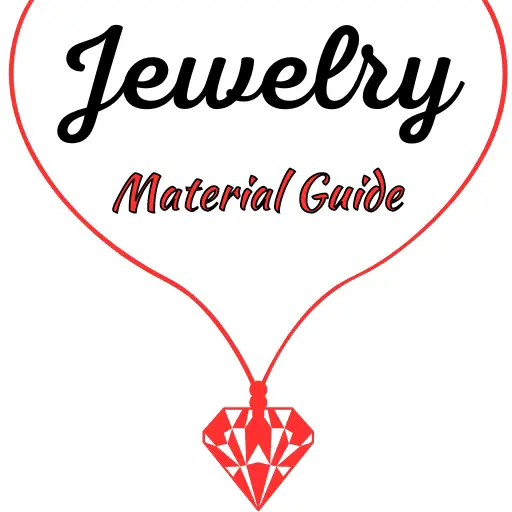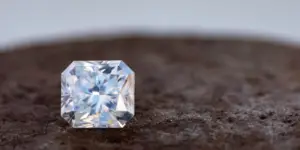Moonstone and opal are two of the most beautiful color-shifting gemstones known to man. Both have a milky, whitish body color in their most common version, but they display very different colors. However both are captivating and fascinating stones that are often used in jewelry.
If you’re looking to figure out what kind of gemstone you’ve got, or want to decide which of these two you should get, read on to find out the main differences between them.

Moonstone vs opal
Moonstone has a blue glow just below the surface of the stone, and it shifts within the stone when you move it, while opal has small clusters of rainbow-colored sparks or shards, and different parts shine when you move the stone. These gemstones are also made of different materials, with opal having a high moisture content while moonstone has none.
There is also a price difference, with opals fetching a much higher price point than moonstone, simply because their fire attracts buyers more.
Moonstone is a type of feldspar, and this is one of the most common minerals within the earth’s crust. This is one of the reasons moonstone isn’t as expensive as opal. Opal on the other hand is a type of hydrated silica, and it does contain a high amount of moisture for a stone.
Let’s take a closer look at these differences so we can understand both gemstones better.
Opal is water-sensitive, moonstone is not
Opals are very sensitive to water and moisture in general. Anywhere between 6% and 21% moisture content is normal for opal, and it is very susceptible to moisture fluctuations. An opal soaked in water for several hours loses its milky haze and a lot of its fiery colors. Once it dries back, its colors return.
This is why you should not take opal jewelry with you wherever there is water, like the pool, shower, even washing your hands.
Moonstone is not as sensitive to moisture and does not lose its color but it should still be kept away from water as a general rule. Because moonstone is made up of feldspar, it may dissolve slowly and erode when kept in water.
Moonstone has a glow while opal has fire
Due to the way these two stones are made up, they shine differently. Moonstone is made up of thin layers of different types of feldspar, mainly orthoclase. These layers have a microcrystal structure and when the light hits just right, a bluish glow appears just below the surface of the gemstone. If you move the stone, the light source, or your viewing angle, you’ll notice the glow shifting within the stone, always meeting your eye.
This is because it’s actually evenly interspersed within the stone. Sometimes it may appear slightly iridescent, and sometimes it may appear hazy, with less blue and more white and not very well focused. Moonstone is most prized when it comes with a strong blue glow within it.
Read also: What Is Grape Agate ?
Opal is a very different color, and its sparkle comes in the shape of highly iridescent bands, shards, or tiny flacks, depending on the quality of the opal. The most common opal has a hazy, milky body with rainbow colored fire. The fire itself is produces because of the tiny hydrated silica spheres, and they way they are arranged within the stone. They work a bit like a prism, refracting light.
Darker colored opal has a much brighter fire by comparison, because of the contract between the darkness and the shimmer beneath the surface. There is also fire opal, which has a nearly clear orange body with warm-colored fire (blue, orange, red, pink, very little green or blue)
Both moonstone and opal have their glow and fire within the stone, and you should be able to see some depth within the stone as you turn it. If the glow is only on the surface it’s most likely a counterfeit gemstone.
Opal is more expensive than moonstone
Because opal displays a more pleasing array of colors it comes with a higher price point. This however depends a lot on the quality of the opal, how bright the fire is, how clear the opal body is, and how dark it is. A hazy white opal will likely also have a faint fire, and thus will be cheaper than a white opal that is translucent and has strong fire.
It’s difficult to price an opal since it’s a very subjective affair, and different jewelers will give you different quotes. If you’re looking for a bright opal you can expect around $45 for a 1 carat piece, though it can get much more expensive than that depending on the cut quality. A 3-3.5 carat opal can get to $400.
Moonstone is much more affordable, as a 3-3.5 carat piece with a bluish sheen can go for as low as $17. Milkier (more opaque) pieces may be even cheaper.
Moonstone stands for intuition, opal stands for emotional stability
There is a difference in what moonstone and opal symbolize, though both have a connection to emotions, and water.
Moonstone is connected to intuition, premonitions, the inner goddess, the moon cycle, emotional highs and lows, communing with spirits, and may have a calming or enhancing effect on one’s emotions. Some people believe a moonstone worn at night may offer protection, as a form of moonlight.
Opal on the other hand has a different meaning, yet is still connected to feminine energy. It may help improve or balance moods, aid pregnant women, mothers, or those looking to get pregnant. Because of this opal has also been linked to fertility, purity, and also desire.
In ancient times the opal was believed to be an all-round good luck charm, because it was thought to represent all the energies of each stone it reflected through its colors.
Both moonstone and opal are soft gemstones
A key point when looking at moonstone and opal, no matter which you choose, is their softness. On the Mohs scale of hardness opal ranks a 5.5-6 while moonstone is a 6-6.5, just slightly harder. This means both stones need a protective setting such as a bezel setting, and both need to be cut into cabochons to have a more stable structure.
Because they are cut into cabochons they usually come in larger sizes, so you’re likely going to find them in 3-5 carat a piece, unlike diamonds that can also come in very small sizes.
Keep in mind that opal and moonstone easily scratch and they should be kept away form water or excessive moisture. We recommend you keep these gems only for occasional wear.
Don’t confuse opal or moonstone with opalite
When buying moonstone you need to be careful to make the distinction between true moonstone and opalite. True moonstone may have a milky haze but will always reflect some bluish-whitish light back. Opalite reflects more colors that bleed into one another. So from orange to yellow to green to blue, with a hazy, milky, bluish appearance.
Moonstone does not reflect as many colors, and the whitish ones don’t have a blue tone, only a blue glow as you shift the light.
Opalite is actually a man-made opalescent glass, and it’s designed specifically to reflect a wider range of colors than moonstone, more like opal, but without fracturing the opalescence.

I’m the main author for jewelrymaterialguide.com. I started this site after we did tons of research before our wedding and noticed that there is information about rings, jewelry, and so on that is really hard to find on the internet.






